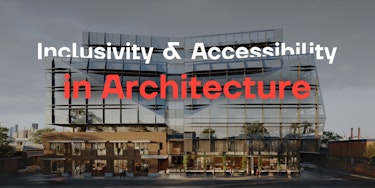As we continue to evolve as a society, we have come to appreciate the importance of inclusivity and accessibility in all aspects of our lives. One area that has seen significant progress in this regard is architecture. Architects are increasingly incorporating inclusive design principles and accessibility features into their projects to ensure that everyone, regardless of ability or background, can access and use the built environment. In this article, we will explore the future of inclusivity and accessibility in architecture and the trends that are shaping this important field.
The Importance of Inclusivity and Accessibility in Architecture
Architecture is not just about creating aesthetically pleasing structures. It is about creating spaces that are functional, safe, and accessible for everyone. Inclusivity and accessibility are fundamental aspects of architecture because they ensure that people of all abilities and backgrounds can participate in society and have access to essential services and facilities.
For people with disabilities, accessibility is not just a convenience; it is a necessity. Without accessible buildings and infrastructure, people with disabilities face significant barriers to employment, education, and social participation. Inclusivity is also essential because it ensures that everyone feels welcome and valued in their surroundings.
Accessibility in architecture is regulated by a series of codes and standards, such as the Americans with Disabilities Act (ADA) and the International Building Code (IBC). These codes and standards provide guidelines for architects to design buildings that are accessible and usable for people with disabilities. However, accessibility is not just about complying with codes and standards; it is about creating spaces that are functional and welcoming for everyone.

The Future of Inclusivity and Accessibility in Architecture
The future of inclusivity and accessibility in architecture is bright, with many exciting developments on the horizon. Here are some of the trends that are shaping the future of architecture:
1. Universal Design: Universal design is a design philosophy that aims to create spaces that are accessible and usable for people of all abilities. It involves designing buildings, products, and environments that can be used by as many people as possible, regardless of their age, size, ability, or disability. Universal design is becoming increasingly important in architecture, and we can expect to see more buildings designed with this approach in mind.
The principles of universal design include flexibility in use, simple and intuitive use, perceptible information, tolerance for error, low physical effort, and size and space for approach and use. Universal design not only benefits people with disabilities but also benefits everyone. For example, a building with a wide entrance and a ramp benefits people who use wheelchairs, but it also benefits people who use strollers or have heavy luggage.

Credit: WebUrbanist
2. Smart Buildings: Smart buildings are buildings that use technology to improve energy efficiency, security, and comfort. They can also be designed to be more accessible and inclusive. For example, smart buildings can use sensors and artificial intelligence to adjust lighting and temperature automatically, making the environment more comfortable for people with sensory disabilities. They can also use voice-activated systems to control appliances, making it easier for people with physical disabilities to use them. Smart buildings can also provide real-time information about the building, such as occupancy levels and air quality. This information can be useful for people with disabilities who may need to plan their routes or avoid crowded areas.

Credit: ArchDaily
3. Sustainable Architecture: Sustainable architecture is a design philosophy that aims to create buildings that are environmentally friendly and energy efficient. It is becoming increasingly popular as people become more aware of the impact of climate change. Sustainable architecture can also be designed to be more accessible and inclusive. For example, green roofs can provide a natural space for people to relax, and they can also help to reduce noise pollution, making the environment more comfortable for people with sensory disabilities. Sustainable architecture can also incorporate natural light and ventilation, which can benefit people with seasonal affective disorder or asthma. Buildings can also be designed to minimize their impact on the environment by using recycled and low-emission materials, reducing water consumption, and using renewable energy sources. By incorporating these features, sustainable architecture can create buildings that are not only environmentally friendly but also accessible and inclusive.

Inclusivity and accessibility are essential aspects of architecture that ensure that everyone can participate in society and have access to essential services and facilities. The future of inclusivity and accessibility in architecture is bright, with many exciting developments on the horizon. Universal design, smart buildings, and sustainable architecture are just a few of the trends that are shaping this important field. As architects continue to incorporate these principles and features into their projects, we can look forward to a more accessible and inclusive built environment for everyone.
